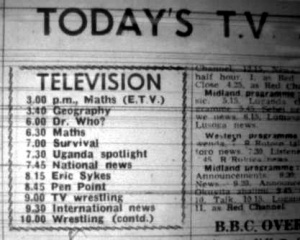Uganda
UGANDA is located in the highlands of Central East Africa. It was made a British Protectorate in 1896. In 1962 it achieved its independence. It is a member of the British Commonwealth.
Profile
| Country Number (13) | 1966 | FIRST WAVE |
| Region | Africa | Commonwealth |
| Television commenced | 1963 | |
| Colour System | 1975 | PAL |
| Population | 1966 | 6.8 million |
| TV Sets | 1966 | 5,300 |
| Language/s | English |
Television Stations / Channels
Uganda began its television service in 1963, soon after achieving its independence from Britain. Colour transmissions began in 1975 using the PAL colour broadcast system. At the time there was just one television station: Uganda Television Service, which was operated by the Ministry of Information, Broadcasting & Tourism in Kampala.
Although the population was over 6.8 million, in 1966 licensed television sets numbered only 5,300.
The main language of Uganda is English, plus many tribal dialects.
DOCTOR WHO IN UGANDA
Uganda was the 13th country to screen Doctor Who. It was the fourth in Africa (see Selling Doctor Who).
BBC Records
The Stanmark Productions Ltd' advertisement from 1966, identifies Uganda as one of twelve countries screening Doctor Who in that year.
The Seventies records a sale of 15 stories. The Handbook identifies these as being ten from the first eleven William Hartnell stories, with the exception of Inside the Spaceship, plus five Patrick Troughton stories from season four.
In DWM, Uganda is identified in 13 story Archives, including Inside the Spaceship: (B, C, D, E, F, G, H, J, K, L, FF, HH, JJ).
Stories bought and broadcast
WILLIAM HARTNELL
Eleven stories, 53 episodes:
| A | An Unearthly Child | 4 |
| B | The Daleks | 7 |
| C | Inside the Spaceship | 2 |
| D | Marco Polo | 7 |
| E | The Keys of Marinus | 6 |
| F | The Aztecs | 4 |
| G | The Sensorites | 6 |
| H | The Reign of Terror | 6 |
| J | Planet of Giants | 3 |
| K | The Dalek Invasion of Earth | 6 |
| L | The Rescue | 2 |
Uganda therefore purchased the standard package of GROUPS A, B and C of the William Hartnell stories.
The programme was supplied as 16mm black and white film prints with English soundtracks.
Origin of the Prints?
It's possible that Nigeria or Zambia sent its prints to Uganda after broadcast.
PATRICK TROUGHTON
Five stories, 22 episodes:
| FF | The Highlanders | 4 |
| GG | The Underwater Menace | 4 |
| HH | The Moonbase | 4 |
| JJ | The Macra Terror | 4 |
| KK | The Faceless Ones | 6 |
The programme was supplied as 16mm black and white film prints with English soundtracks.
Origin of the Prints?
Since Uganda was the second country to screen these five stories, they must have been supplied with their own set of prints.
Transmission
WILLIAM HARTNELL
The series started on Tuesday, 18 January 1966, screening every Tuesday, running non-stop for 53 weeks until 17 January 1967. The timeslot was variable, ranging from 5.20pm to 7.00pm.
Fate of the Prints?
The next African country to air the Hartnell stories was Kenya, in June 1966. It is possible that Uganda sent its prints of the Hartnell stories to Kenya.
PATRICK TROUGHTON
Just on 18 months later, the series returned on 28 September 1968, but with Patrick Troughton as the Doctor. Neither The Tenth Planet and The Power of the Daleks screened in Uganda, so viewers were offered no on-screen explanation for the change in appearance of the lead character.
The second run - 22 episodes - played on Sundays, at 7.00pm, and lasted for 24 weeks: no episodes screened on 21 December 1968 and 22 February 1969. The final Doctor Who episode to air in Uganda was part 6 of The Faceless Ones on 8 March 1969.
There is no record that Uganda screened Doctor Who again, even after the switch to colour in 1975.
Fate of the Prints?
Uganda may have sent its prints of the Troughton stories to Zambia.
TV listings
| ← AIRDATES ...... (CLICK ICON TO GO TO TABLE SHOWING EPISODE BREAKDOWN AND AIRDATES - N/S = story title is Not Stated) |
TV listings have been obtained from the newspaper Uganda Argus (from Kampala).
Listings initially gave the series name as "Dr Who", before adopting "Dr Who?" (complete with question mark) as the standard. None of the listings identify any episodes by title. We can only assume that all stories aired in the correct story order.
Note: the TV listing for 18 January 1966 does not have a billing for Dr Who. With the run of episodes ending on 17 January 1967, that makes the run only 52 rather than 53 episodes long. To account for the 53 episodes that there should be, we have to assume that the series did debut on 18 January.
There is also no billing for Dr Who on 1 February 1966, but that is only because the TV listings omit (a printing error?) programmes between 6.00pm and 7.00pm, which is when Doctor Who was airing; again we can assume it did play that evening.

